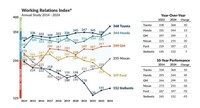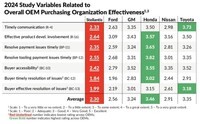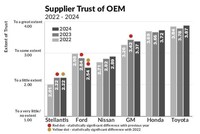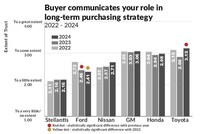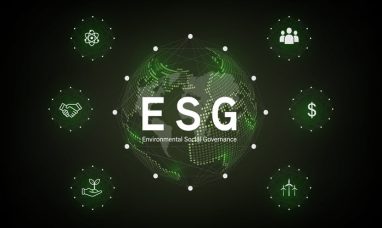DETROIT, May 20, 2024 /PRNewswire/ — Results of the 24th annual North American Automotive OEM – Supplier Working Relations Index® (WRI®) Study that evaluates relations between US automakers and their suppliers were released today by Plante Moran.
The Study shows five of the six OEMs improved overall relationships while managing continued tensions over cost-recovery issues related to materials and tooling, and the overall fairness of supplier commercial relations in general. These two issues have been created and compounded by changing electric vehicle demand that has automakers switching to hybrid configurations, or canceling EV programs and again ramping up conventional powertrain production while rising costs are squeezing suppliers.
In this year’s study, the WRI® scores show Toyota, Honda and General Motors finishing 1-2-3, followed by Nissan, Ford, and Stellantis in last place. Toyota jumped 30 points to 368 that puts the automaker alone in the upper good-very good category and is its highest score in the WRI since 2007 when they topped out at 415. Nissan also gained 30 points. Honda gained 13 points and scored 344. Ford dropped 22 points year-over-year putting the company in fifth place or two places and 70 points lower since 2016. Stellantis gained seven points but remains in last place at 152. Between Toyota and Stellantis is a gap of 216 points.
The Working Relations Index measures the total commercial relationship, which is a function of perceived trust, timely communication, mutual profit opportunity, assistance, and a reduction in friction in dealings with automakers.
“With all the challenges and conflicts facing suppliers this past year, it’s not surprising that some automakers dropped even further in their scores. But what might be surprising to some is that several automakers improved their scores significantly during the past year. This shows that piece price economics alone is not what drives the automakers’ WRI score but that the score also reflects the tangible and intangible costs to serve the OEMs,” says Dave Andrea, Principal in Plante Moran’s Strategy and Automotive & Mobility Consulting Practice.
“The primary driver behind the largest WRI point gains is sharing risk and cost in an equitable manner while relentlessly pursuing cost reduction,” says Andrea. “This will enhance the mutual long-term financial and innovative capability of the customer and the supplier. OEMs doing this best integrate their suppliers into their corporate strategy and keep WRI-related principles front and center in their dealings.”
TOP TAKEAWAYS FROM THE WRI STUDY
With the overall industry undergoing major changes in the shift to EVs, suppliers identified several common issues critical to OEM success, says Andrea. Among them:
- The automakers need to revise outdated contract terms and conditions and purchasing practices built over decades for the new realities of the EV transition and beyond. There must be more flexibility. OEMs can’t simply say, “No material cost recovery” when suppliers are dealing with unused capacity due to delayed programs. Contract structures need to be updated to deal fairly with the risks inherent in transitioning into EVs, adopting new safety and infotainment technologies, sourcing scarce new materials, and increasing competition from China. In uncertain, high-risk times there needs to be more trust, transparency, and flexibility, not less. Fixed terms and conditions must be restructured to deal with new market conditions.
- Corporate leadership beyond purchasing — especially finance and engineering — need to cooperate in managing supplier cost and risk reduction requests. The best OEMs know faster responses, new cost recovery formulas and the like are needed if they expect suppliers’ best efforts on their behalf. In addition, suppliers have a choice as to who they work with and can make decisions to manage down business with specific OEMs.
- Annual price reduction “productivity” demands by OEMs must incorporate the cost of the total supplier relationship. Suppliers and OEMs must look for annual cost reductions through true productivity gains – getting more output with fewer input resources. This takes investment which comes from adequate returns on investment for suppliers. Meaningful cost-reduction suggestions made by suppliers can be evaluated and adopted more quickly by OEMs if design, engineering, and purchasing are working together. This would expedite revalidation of parts using lower-priced materials, reduce complexity, and lower parts count by part consolidation. Better cost estimating and target pricing by OEMs and suppliers would help correct this.
“There’s no question the industry has run into unprecedented and unexpected challenges in the shift to EVs. However, OEMs that effectively address these issues are generally stronger, more profitable, and become customers of choice for suppliers,” said Andrea.
HONDA REMAINS FIRST IN PURCHASING EFFECTIVENESS, FOLLOWED BY TOYOTA and GENERAL MOTORS
“Purchasing Effectiveness” is another important overall measure. It rates OEMs on seven important variables, as indicated in Figure 2. Again this year, Honda ranked the highest in purchasing effectiveness which involves timely communication, resolving issues, and buyer accessibility among other characteristics shown in the table.
In overall OEM Purchasing Organization Effectiveness, Honda led in six of the eight categories with a composite average score of 3.46. Toyota purchasing was second and led in two important categories — timely communication and buyer effectiveness in resolving issues. GM was third with a composite score of 3.24, followed by Nissan at fourth with 2.91. Ford was fifth with 2.56, a drop from last year, and Stellantis was last in all seven categories at 2.30.
WRI CORNERSTONES: OEM-SUPPLIER TRUST AND COMMUNICATION
The Study has shown trust and communication to be the cornerstones of good working relations, especially in the high-risk environment automakers and suppliers are now dealing with. Billions of dollars and thousands of jobs are at stake.
While the key to mutual success is trust, trust is based on three factors: having the OEM customer set realistic expectations; delivering on commitments; and sharing information.
Figure 3 shows overall Trust with Toyota, Honda, and GM having the highest Trust rankings.
However, this year Nissan had a slight improvement, Ford dropped significantly, and Stellantis was unchanged. Note how the black bars of the Trust rankings track the overall WRI rankings.
TIMELY COMMUNICATION KEY
Specific in Buyer Communication is sharing information on the OEM’s long-term purchasing strategy on a timely basis (Figure 4). Here the bottom three OEMs match their order in the WRI® while the top three are reordered slightly with Toyota first, GM second followed by Honda.
“All six of the OEMs need to improve in this important area,” said Andrea. “In this uncertain and high-risk business environment, communication is key, because supplier CEOs have an increasing number of OEM customers they can work with. Their decision often comes down to asking and answering three key questions: Who do I trust? Where will I get the best return on investment? And what is the prospect for future business? So, it’s in the OEM’s best interest to maintain open and honest communication with its suppliers.”
However, communication goes beyond the external OEM-to-Supplier communication, said Andrea. The OEMs also must improve their internal communication to better align purchasing, engineering, and manufacturing so they’re working together to achieve the same corporate goals – greater efficiency, reduced cost, and greater speed. “This will take cost and time out of the entire supply chain while helping both the OEMs and suppliers achieve their cost and financial performance goals,” said Andrea.
When asked about OEM interactions between purchasing, engineering, and manufacturing and its impact on serving the customer, suppliers’ rankings of the OEMs generally matched the WRI, with Ford and Stellantis the worst and Toyota and GM the best at coordinating the three functions.
ENVIRONMENTAL, SOCIAL AND GOVERNANCE TOPICS
Supplier relations are also being impacted by the global requirements of environmental, social, and governance (ESG) compliance. ESG requirements are becoming part of a suppliers’ performance scorecard. In the survey, suppliers were asked four questions related to ESG policy communication, supplier resource commitments, joint efforts and return expectations. The averaging of the supplier responses to these questions ranks the OEMs exactly as the suppliers rank the OEMs on the WRI. This indicates that better supplier relationships correlate with better ESG performance.
About the Working Relations Index® Study
Now in its 24th year, the 2024 North American Automotive OEM-Tier 1 Supplier Working Relations Index® Study was conducted by Plante Moran from mid-February to mid-April. Respondents are executives from Tier-1 suppliers serving Ford, General Motors, Honda, Nissan, Stellantis, and Toyota. The annual Study tracks supplier perceptions of working relations with their automaker customers in which they rate them across the eight major purchasing areas broken down into 20 commodity areas. The results of the Study are used to calculate the WRI® which can then be used to calculate the economic value of working relations based on a proprietary economic model.
The respondents to the survey were 696 supplier executives from 429 unique Tier-1 suppliers. This number of responses easily represents 50% of the six OEM’s North America annual purchases. The sales personnel provided data on 2,210 buying situations (e.g., one supplier responding can sell into multiple components groups of one OEM, such as chassis parts and powertrain for two buying situations). Demographically, the supplier respondents represent 41 of the Top 50 NA suppliers and 69 of the Top 100 NA suppliers.
The Study was founded in 2001 by Dr. John Henke, CEO of Planning Perspectives, Inc., and acquired by Plante Moran in 2019. The automakers utilize the Study carefully because the attributes measured by the Working Relations Index® (WRI®) are highly correlated to the benefits OEMs receive from their suppliers, including competitive pricing, investment in innovation and technology, and better program launch support. These benefits contribute to the OEM’s operating profit and competitive strength.
About Plante Moran: Plante Moran is among the nation’s largest audit, tax, consulting and wealth management firms and provides a full line of services to organizations in the following industries: manufacturing and distribution, financial services, service, healthcare, private equity, public sector, real estate, construction, and energy. Throughout the firm’s 100 years in business, Plante Moran has grown to a staff of more than 3,800 professionals throughout the United States with international offices in Shanghai, China; Mumbai, India; Tokyo, Japan; and Monterrey, Mexico. Plante Moran has been recognized by a number of organizations, including Fortune magazine, as one of the country’s best places to work. For more information, visit plantemoran.com.
![]() View original content to download multimedia:https://www.prnewswire.com/news-releases/toyota-soars-ford-plummets-honda-gm-nissan-and-stellantis-make-gains-in-2024-working-relations-study-302149681.html
View original content to download multimedia:https://www.prnewswire.com/news-releases/toyota-soars-ford-plummets-honda-gm-nissan-and-stellantis-make-gains-in-2024-working-relations-study-302149681.html
SOURCE Plante Moran

Featured image: Megapixl © Yuyang




